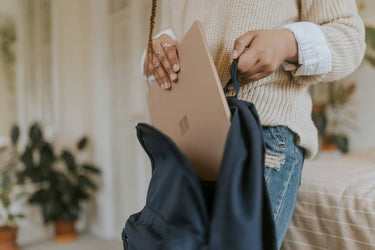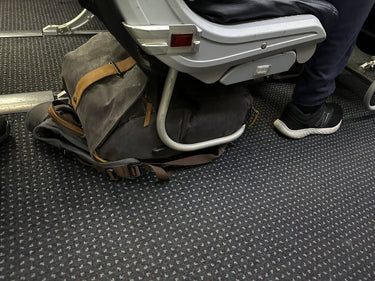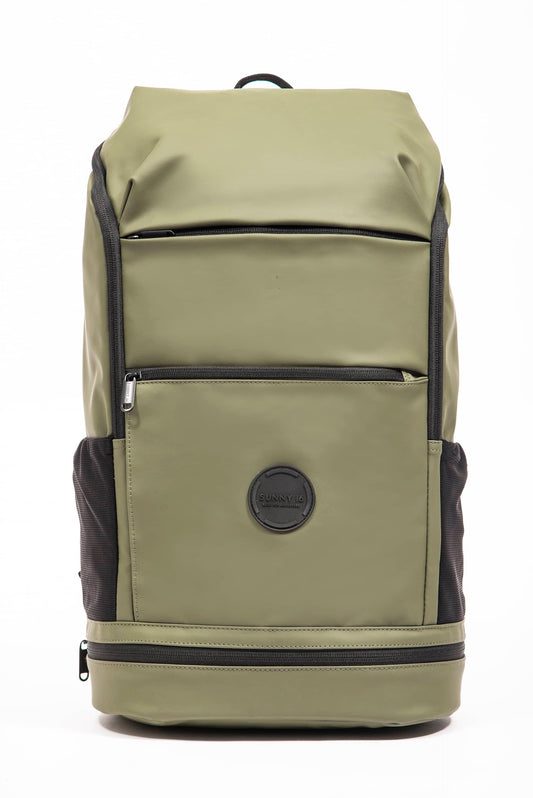
How to Pack a Backpacking Pack for Hiking and Camping
Share
One of the things that first come to mind when you hear the word backpack is camping. But the truth is, a good backpack can turn into a hiking trip or camping backpack easily without going anywhere. This article will help you to pack like a pro, especially if you are traveling with your family and need some extra space for all their stuff too.
Packing a backpack can be a really daunting task. There are so many different models and sizes to choose from, it can be confusing to know where to start. We have taken the hard work out of it for you by showing you how to pack a backpack for a hiking trip.
So, let's jump in …
How to Pack a Backpack for Hiking
-
How to Pack a Hiking Backpack
-
How to Pack a Backpacking Pack
-
How to Pack a Hiking Backpack Diagram
-
How to Pack a Backpacking Bag
-
Practical Hiking Backpack Checklist
-
Staying Safe During Hiking
-
Match Your Gear to Your Hiking Trip
-
Bring the Right Backpacking Gear
How to Pack a Backpack for Hiking
Whether you're an experienced hiker or a beginner, packing a hiking backpack can seem like a demanding task. There are many things to consider: what type of terrain you'll be hiking on, what kind of weather you'll be dealing with, how long you'll be hiking for, your own comfort level, what you'll need to bring with you, and more. Depending on the length and difficulty of your hike, you will need to pack different items. But don't worry, we're here to help. Follow our simple tips and you'll be an expert in no time.
Here are a few tips on how to pack a backpacking pack:
First, decide what type of terrain you'll be hiking on.
Make sure you have the essentials: water bottle, food/snacks, first-aid kit, multi-tool, headlamp, sunglasses, sunscreen, hat, insect repellent, matches, stove, shelter, and extra clothes.
Once you have all of that, pack heavier items at the bottom of the backpack and lighter items on top.
To make it easy, place waterproof stuff at the bottom of your pack (or add a dry bag), and light items like clothing and food on top.
Pack your sleeping bag at the bottom of the pack and wrap any additional clothes or a towel around it to keep it from getting smelly.
Finally, don't forget to pack a map and compass in case you get lost!
Once you have packed it, take a few minutes to zip it up and make sure everything is tight. This will make it much easier when you are hiking and carrying it, so it should be your last step.
Pack your backpack for a hiking trip the right way & enjoy the great outdoors!
How to Pack a Backpacking Pack
One of the most important things to consider when backpacking is how you will carry all of your gear. A backpack is an essential piece of equipment, but it is not always easy to pack one properly. There are a few tips and tricks that can help make packing a backpack easier and more efficient.
A properly packed backpack can be one of the most valuable pieces of gear you bring along with you on your backpacking trip. By properly packing your backpack, you will have a more comfortable and enjoyable experience. There are several things to consider when you pack your backpack, including the size and the shape of the bag itself. The way you pack your backpack will depend on the type of trip you are going on, and what your packing needs will be.
By following a few simple tips, you can pack your backpack better and reduce the chances of it being a major hassle during your trip.
To pack a backpack for backpacking, again, start by packing the heavier items first, such as your sleeping bag and tent. Then, pack your clothing and other essentials, such as food and water. Pack your lighter items, such as your flashlight and first-aid kit.
You should also make sure that your backpack has at least one or two liter(s) of water. Not only will this help keep you hydrated, but it can also help you survive a night in the backcountry if you find yourself without your water bottle.
The last thing you want is for your entire backpack to weigh as much as your tent or sleeping bag. If you pack your backpack too full, it will become too heavy to carry on your hike. This is why it is important to start with the heavier items first.
If you are going on a multi-day hike, make sure to keep your pack weight in mind when packing it. If you are hiking in cold or rainy weather, it is even more important to keep your pack weight down.
How to Pack a Hiking Backpack Diagram
If you're planning a hike, you'll need to pack a backpack with all the essentials. This diagram shows how to pack a hiking backpack so that everything fits securely and doesn't get damaged.
Assuming you have all the necessary gear, packing a hiking backpack is relatively easy. Start by placing the heaviest items in the bottom of the pack, close to your back. Then, fill the middle of the pack with lighter items, such as a sleeping bag and clothing. Finally, put the lightest items, like snacks and a first-aid kit, at the top of the pack.
How to Pack a Backpacking Bag
In order to pack a successful backpacking bag, there are a few key things to keep in mind. First, it is important to choose a bag that is the right size for you and your belongings.
Second, pack light by only bringing the essentials and leaving non-essentials at home. Next, fill in the smaller spaces with lighter items, such as clothes and toiletries. Finally, make sure to distribute the weight of your belongings evenly in the bag so that it is comfortable to carry.
Practical Hiking Backpack Checklist
Packing a bag with the essentials is key to preparing for your backpacking trip. However, some items should absolutely not be left at home.
If you plan on doing some hiking and camping during your trip, these backpacking checklist items should help you prepare. Some important backpacking checklist items for hiking are:
☐ Solid Backpack
A sturdy and comfortable backpack is vital for carrying all of your gear. A good backpack will distribute the weight of your load evenly and should be durable.
☐ Sleeping Bag
A sleeping bag is essential for staying warm during chilly nights and cold mornings.
☐ Good boots
You need high quality and comfortable boots for your trip. Some boots need breaking in, so make sure to wear them around the house and walk in them a few times before your trip.
☐ Hiking Poles
Sturdy hiking poles will help you with balance when you are tired and carrying heavy backpacks.
☐ Camping Stove
A camping stove is a must-have item. Stoves require fuel, which you will need to buy in camp stores or bring with you if you plan on doing some backpacking cooking.
☐ Cooking Kit
A cooking kit can be a source of convenience and enjoyable outdoor cooking. Some kits include utensils and pots, which make cooking easy and fun.
☐ Water Purification Kit
You can never be too careful with water, which is why it's wise to bring a backpacking water filter to get safe drinking water from streams and lakes.
☐ First Aid Kit
You should always have a first aid kit when backpacking because any injuries or illnesses can crop up at any time. Make sure you have a first aid kit that is well stocked with bandages, antiseptic, alcohol wipes, and any other items to treat colds, sore throats, cuts, scrapes, bruises, sunburns, insect bites, blisters, and skin cream.
☐ Garbage Bag
Anytime you are camping, you should bring a garbage bag. You can use it to pack out the trash or leave it at the campsite so it can be collected by park staff.
☐ Smartphone
It is always handy to have a smartphone with you. You can take pictures, message people, and make videos when backpacking.
☐ Camera
A camera is always a great thing to have when backpacking. It can capture memories of your trip, and it is also useful for filming trails, plants, animals, waterfalls, etc.
☐ Reusable Shopping Bags
Bring reusable shopping bags. It is great to take on grocery runs and other trips to the store.
☐ Disposable and Reusable Water Bottles
Bring an assortment of reusable and disposable water bottles. You can use them on hot days or treat lakes.
☐ Camping Chairs
Bring camping chairs for when you are doing some sitting around.
☐ Picnic Table
You'll want to bring a picnic table along so you can sit and enjoy the great outdoors.
☐ Functional Lantern
Use a lantern to light up the nighttime when you are camping. A flashlight can also be very useful when you are camping in the dark.
☐ Camping Gear
Get some gear for camping such as tents, a hammock, sleeping bags, and plenty of food. Many campers want to bring their dogs along, but it is not always a good idea. In areas with rabies and dog-fighting, there are rules regarding how long a pet may be kept at a backpacker's campsite, so please check before you leave home.
☐ Camping Supplies
An extra set of clothes and underwear. When packing for a camping trip, you want to bring extra socks and clean underwear. Also, if you plan on hiking for days, pack hiking boots and walking shoes. When packing for a week-long trip, you will probably want to bring a change of clothes.
☐ Writing Material
Carry a small notebook and pen in your pocket. You can use it to write reminders, jot down questions you need to ask, or record your accomplishments. It’s also useful for writing your name on things like backpacks and tent stakes.
How to Stay Safe During Hiking
You should take a few precautions when planning your trip to ensure your safety, as well as that of anyone else who may be on the trail with you. When hiking, you may be far away from any help that may be available if something happens. Make sure to tell someone about your plans, and when you are expected back home.
It may sound silly, but your first line of defense is not an implementation. Your body is the most effective way to protect yourself from the elements. Protect your head by wearing a helmet, and your face by wearing sunglasses. Put on sunscreen, and wear long-sleeved shirts and pants. When you hike in a group, hikers in the back can lose sight of those at the front. Protect the back of your neck and the back of your head by wearing a sun hat.
In order to avoid ground injuries caused by sticks and stones, especially on smooth trails, wear hiking boots or shoes with good grip. And choose boots that are wide enough for your feet.
Do not wear flip-flops or sandals when hiking on trails, even though they may provide some protection. In some areas, even hiking boots may not provide adequate grip on muddy trails. Wear gaiters to prevent leaves and other debris from being kicked up from the ground and into your shoes. When hiking off-trail, wear shoes or boots with good traction. The soles of these shoes should be well-tread, with a sufficient number of lugs for the terrain.
Match Your Gear to Your Hiking Trip
Whether you're preparing for a weekend in the woods or a week-long trek, it's important to consider the type of backpacking trip you're going on. Hikers should also consider their gear and what will work best for the destination. For example, if you're planning on a backpacking trip in a cold climate, you may want to bring a pair of hiking boots that are insulated and waterproof. In addition, a tent that is rated for windy conditions will help keep you warm and dry. Packing tips are also critical to consider. Here are some helpful packing tips to consider when packing for your next backpacking trip.
The Right Backpacking Food
Plan your meals and bring the right backpacking food. This will help ensure that you have the energy you need to get back to camp each day. Proper food selection will also help keep you hydrated and reduce the risk of spoiled food.
Plan Ahead for Campsite Cleanup
While hiking, there is always the possibility that you will encounter small obstacles or even bigger hazards, such as a river. Plan ahead for the unexpected by having a basic first aid kit and cleaning supplies in your backpack.
Wear the Right Gear
Comfortable hiking boots and socks are a must. Also, consider bringing layers that can be added or removed when the weather gets warmer or colder.
Bring the Right Backpacking Gear
You can make the packing list for your hiking or backpacking trip a lot easier by bringing items that you may not need on the first day. Then, when you get to camp, you can take out the unnecessary things and leave just what you will need on your trip.
Take time setting up a camp
Take some extra time to set up camp. This will allow you to get a nice fire going, have your food cooking and make your tent ready to go.
Enjoy the journey
Even though you have planned your trip, there is still a lot that happens along the way. Hiking is a great way to explore destinations you may not have seen before.
Up Next: Sunny 16 Voyager Hiking Backpack
Whether you’re hitting the beach or the trails, the Sunny 16 Voyager backpack is the perfect way to carry your essentials. With a spacious main compartment and plenty of pockets, this backpack has room for everything you need.

The comfortable straps make it easy to carry. And the waterproof material keeps your belongings dry in case of bad weather.





























